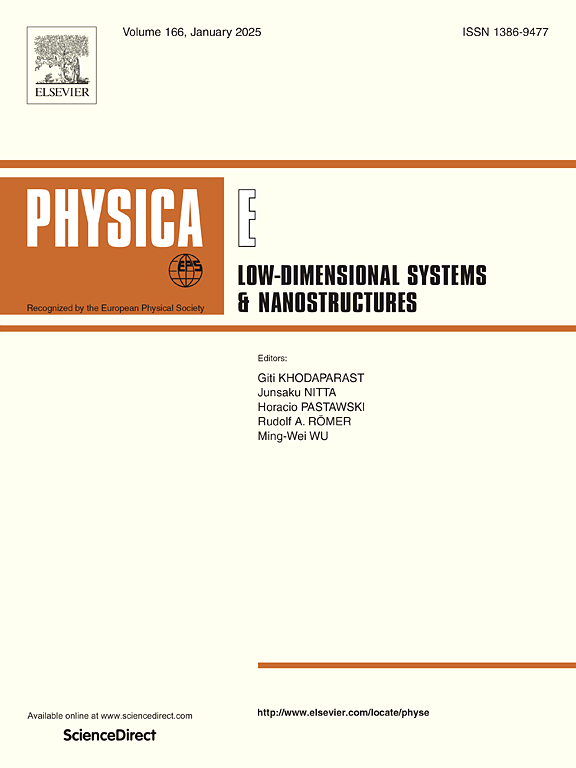GST and BFO assisted microring resonator for nanoplasmonic applications
IF 2.9
3区 物理与天体物理
Q3 NANOSCIENCE & NANOTECHNOLOGY
Physica E-low-dimensional Systems & Nanostructures
Pub Date : 2024-11-09
DOI:10.1016/j.physe.2024.116149
引用次数: 0
Abstract
In this paper a Metal-Insulator-Metal configuration based electro-optic microring resonator is designed and simulated by using Bismuth Ferrite and Germanium Antimony Telluride for wavelength filtering, switching and modulator applications. The device works on the phenomena of change in refractive index of the active materials when electric field is applied. Initially, switching and filtering is demonstrated by using bismuth ferrite as an active material inside the ring resonator. Later on, an additional layer of GST is added to the ring resonator resulting in increased light confinement inside the ring resonator in the amorphous state of GST layer. Due to this, resonant dips sharpens which improves the quality factor of the device up to 154. By optimizing the device's structural parameters, a modulation depth of 23.11 dB is achieved with a low loss of 1.6 dB. Additionally, these innovative SPPs plasmonic waveguide structures can accommodate various filtering requirements and have good filtering efficiency.
用于纳米光子学应用的 GST 和 BFO 辅助微孔谐振器
本文利用铁氧体铋和碲化锗锑设计并模拟了一种基于金属-绝缘体-金属配置的电光微波谐振器,用于波长滤波、开关和调制器应用。该装置利用施加电场时活性材料折射率变化的现象工作。最初,通过在环形谐振器内使用铁氧体铋作为活性材料来演示开关和滤波。后来,在环形谐振器中又添加了一层 GST,从而在 GST 层的非晶态下增加了环形谐振器内部的光局限性。因此,谐振骤降变得尖锐,从而将器件的品质因数提高到 154。通过优化器件的结构参数,可实现 23.11 dB 的调制深度和 1.6 dB 的低损耗。此外,这些创新的 SPPs 质子波导结构还能满足各种滤波要求,并具有良好的滤波效率。
本文章由计算机程序翻译,如有差异,请以英文原文为准。
求助全文
约1分钟内获得全文
求助全文
来源期刊
CiteScore
7.30
自引率
6.10%
发文量
356
审稿时长
65 days
期刊介绍:
Physica E: Low-dimensional systems and nanostructures contains papers and invited review articles on the fundamental and applied aspects of physics in low-dimensional electron systems, in semiconductor heterostructures, oxide interfaces, quantum wells and superlattices, quantum wires and dots, novel quantum states of matter such as topological insulators, and Weyl semimetals.
Both theoretical and experimental contributions are invited. Topics suitable for publication in this journal include spin related phenomena, optical and transport properties, many-body effects, integer and fractional quantum Hall effects, quantum spin Hall effect, single electron effects and devices, Majorana fermions, and other novel phenomena.
Keywords:
• topological insulators/superconductors, majorana fermions, Wyel semimetals;
• quantum and neuromorphic computing/quantum information physics and devices based on low dimensional systems;
• layered superconductivity, low dimensional systems with superconducting proximity effect;
• 2D materials such as transition metal dichalcogenides;
• oxide heterostructures including ZnO, SrTiO3 etc;
• carbon nanostructures (graphene, carbon nanotubes, diamond NV center, etc.)
• quantum wells and superlattices;
• quantum Hall effect, quantum spin Hall effect, quantum anomalous Hall effect;
• optical- and phonons-related phenomena;
• magnetic-semiconductor structures;
• charge/spin-, magnon-, skyrmion-, Cooper pair- and majorana fermion- transport and tunneling;
• ultra-fast nonlinear optical phenomena;
• novel devices and applications (such as high performance sensor, solar cell, etc);
• novel growth and fabrication techniques for nanostructures

 求助内容:
求助内容: 应助结果提醒方式:
应助结果提醒方式:


